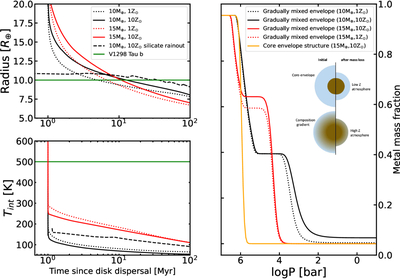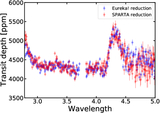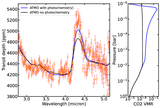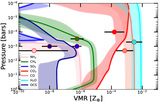Image Details

Caption: Figure 7.
Evolutionary track models of the radius (upper left panel) and of the internal temperature (lower left panel) for V1298 Tau b, considering various ranges of mass and metallicity. Models with two masses (10, 15 M⊕) are calculated, and for each mass, we show two models with solar and 10× solar atmospheric metallicity. Black lines represent 10 M⊕ and red lines represent 15 M⊕. Dotted lines correspond to solar metallicity, and continuous lines correspond to 10× solar metallicity. These ranges of mass and atmospheric metallicity values are chosen as representative and consistent within 3σ of the posterior distribution from the atmospheric retrievals (Table 1). The black dashed models show radius and internal temperature evolution for a 10 M⊕, 10× solar metallicity model including silicate rainout. The evolution tracks for V1298 Tau b have been simulated using interior structure and evolutionary models from A. Vazan et al. (2018, 2024). See Section 4.4 for further details on the models. The green continuous line shows the lower limit of internal temperature inferred from the atmospheric retrievals estimated from this work and the radius of V1298 Tau b. The internal temperature we measure (∼500 K) appears inconsistent with these evolution models and requires alternative formalisms. These models require a 20%–50% by mass H/He envelope; they have been simulated using a gradually mixed interior structure assuming a compositional gradient. In the right panel, we show the atmospheric metallicity profiles that have been used for our evolutionary models presented in the left panel. The same line style and color scheme have been used. For comparison, we also show a core-envelope structure (orange continuous) line for a 15 M⊕, 10× solar atmospheric metallicity model. At the current age, both core-envelope and gradually mixed envelope models can explain the observed composition of the upper atmosphere. Two globally different scenario could be considered: the gradually mixed interior scenario, in which the atmospheric metallicity is expected to increase with age due to removal of upper layers of the envelope, whereas for the core-envelope structure scenario, the metallicity of V1298 Tau b is not expected to change over time, regardless of mass-loss rates (see right panel inset).
Copyright and Terms & Conditions
© 2025. The Author(s). Published by the American Astronomical Society.












